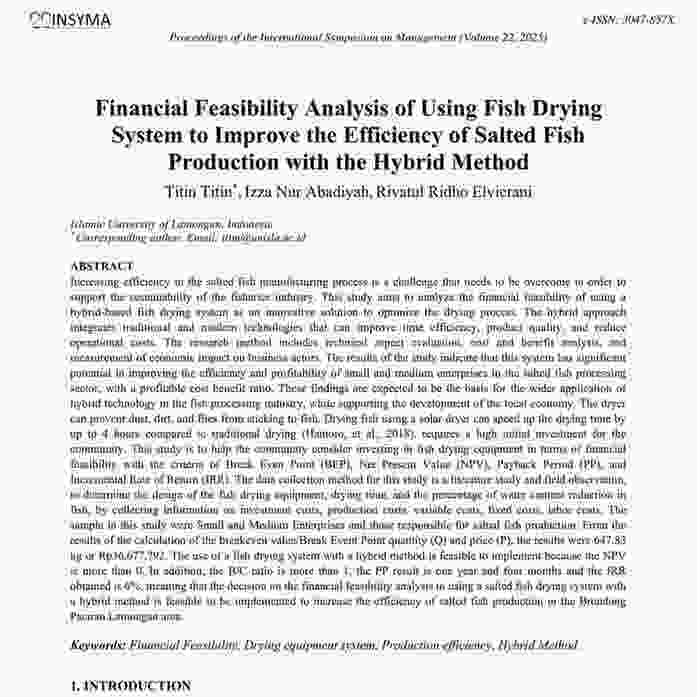Financial Feasibility Analysis of Using Fish Drying System to Improve the Efficiency of Salted Fish Production with the Hybrid Method
Dublin Core
Title
Financial Feasibility Analysis of Using Fish Drying System to Improve the Efficiency of Salted Fish Production with the Hybrid Method
Creator
Titin Titin, Izza Nur Abadiyah, Rivatul Ridho Elvierani
Proceedings Item Type Metadata
meta_title
Financial Feasibility Analysis of Using Fish Drying System to Improve the Efficiency of Salted Fish Production with the Hybrid Method
Abstract/Description
Increasing efficiency in the salted fish manufacturing process is a challenge that needs to be overcome in order to support the sustainability of the fisheries industry. This study aims to analyze the financial feasibility of using a hybrid-based fish drying system as an innovative solution to optimize the drying process. The hybrid approach integrates traditional and modern technologies that can improve time efficiency, product quality, and reduce operational costs. The research method includes technical aspect evaluation, cost and benefit analysis, and measurement of economic impact on business actors. The results of the study indicate that this system has significant potential in improving the efficiency and profitability of small and medium enterprises in the salted fish processing sector, with a profitable cost benefit ratio. These findings are expected to be the basis for the wider application of hybrid technology in the fish processing industry, while supporting the development of the local economy. The dryer can prevent dust, dirt, and flies from sticking to fish. Drying fish using a solar dryer can speed up the drying time by up to 4 hours compared to traditional drying (Hantoro, et al., 2018). requires a high initial investment for the community. This study is to help the community consider investing in fish drying equipment in terms of financial feasibility with the criteria of Break Even Point (BEP), Net Present Value (NPV), Payback Period (PP), and Incremental Rate of Return (IRR). The data collection method for this study is a literature study and field observation, to determine the design of the fish drying equipment, drying time, and the percentage of water content reduction in fish, by collecting information on investment costs, production costs, variable costs, fixed costs, labor costs. The sample in this study were Small and Medium Enterprises and those responsible for salted fish production. From the results of the calculation of the breakeven value/Break Event Point quantity (Q) and price (P), the results were 647.83 kg or Rp36,677,792. The use of a fish drying system with a hybrid method is feasible to implement because the NPV is more than 0. In addition, the B/C ratio is more than 1, the PP result is one year and four months and the IRR obtained is 6%, meaning that the decision on the financial feasibility analysis in using a salted fish drying system with a hybrid method is feasible to be implemented to increase the efficiency of salted fish production in the Brondong Paciran Lamongan area.
publication_date
2025/06/15
pdf_url
https://insyma.org/proceedings/files/articles/Titin_titin.pdf
abstract_html_url
https://insyma.org/proceedings/items/show/358
keywords
Financial Feasibility, Drying equipment system, Production efficiency, Hybrid Method
firstpage
279
lastpage
285
issn
3047-857X
conference
Proceedings of the International Symposium on Management (INSYMA)
Volume
22
publisher_name
Fakultas Bisnis dan Ekonomika, Universitas Surabaya
no article
47
Citation
Titin Titin, Izza Nur Abadiyah, Rivatul Ridho Elvierani, “Financial Feasibility Analysis of Using Fish Drying System to Improve the Efficiency of Salted Fish Production with the Hybrid Method,” Proceedings of the International Symposium on Management (INSYMA), accessed January 11, 2026, https://insyma.org/proceedings/items/show/358.
